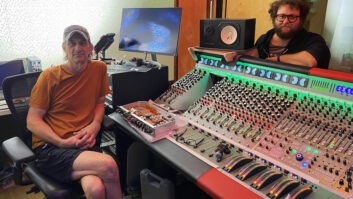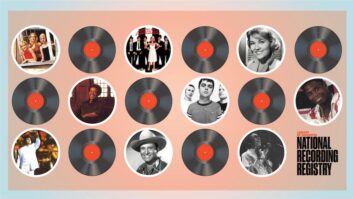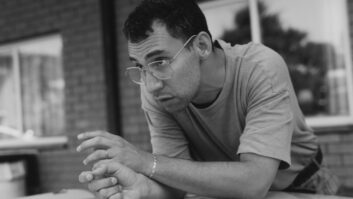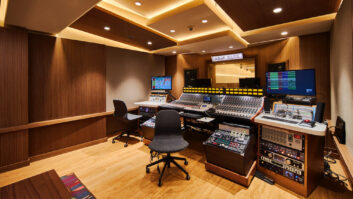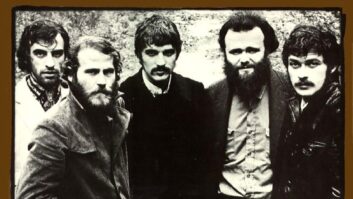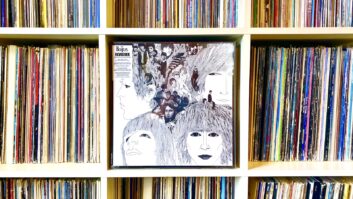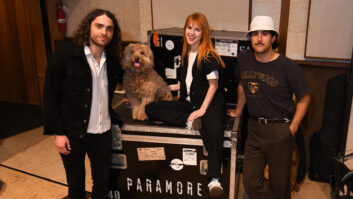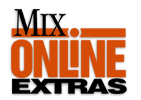
There was a time, not so very long ago, when nearly all “livealbums” were recorded by remote trucks. Typically, a performer orgroup (or, more likely, their record label) would hire the truck tofollow a tour, and then the album would be culled from the tapes ofthat tour. Occasionally, you would find a band — such as theGrateful Dead — who were serious about keeping an archive ofall their performances for posterity and so made simple stereorecordings from the soundboard’s feed, but they were the exceptionrather than the rule in the ’60s and ’70s. When the Dead would put outlive albums through Warner Bros. or, later, Arista, they were alwaysfrom multitrack tapes, often involving a remote truck.
Needless to say, things have changed. Now, there are manygroups who routinely record all of their concerts — some inmultiple formats — and an increasing number even release anentire tour’s worth of shows to their fans, either on CD or over theInternet, or both, without using a remote truck. Stereo DAT is probablystill the most prevalent medium for simple archiving of shows (havingreplaced the vastly inferior analog cassette), but increasingly, we’reseeing bands capture shows on various multitrack media, from MDMs todisk-based systems such as Pro Tools. Recently, we contacted a handfulof engineers to find out what recording equipment they’re carryinggig-to-gig to capture the music for their private vaults or for futurerelease.

STRING CHEESE INCIDENT
Engineer: Jon O’Leary
The popular Colorado jam band String Cheese Incident have releasedin the neighborhood of 70 CDs of their live concerts (most encompassingthree discs) on their own SCI Fidelity Records label during the pastcouple of years. Basically, fans can own just about any SCI show theysee on a tour, and because each night is different (in the Dead/jamband tradition), there’s plenty of incentive for hardcore fans tocollect many or all of their shows.
When Jon O’Leary started mixing the band in 1996, “I just rana stereo soundboard every night because I liked to hear how it came outfor my own sake,” he says. “Most of those are on DAT. Itwasn’t until a year or two into taping that the band started listeningmuch. But then what I also did is I made a tape for them with myaudience microphones, which would usually be at the soundboard, if thesoundboard wasn’t in the last row under a balcony in a theater. If thatwas the case, I’d usually hang my mics from the front lip of thebalcony and then run a couple of cables back to me. I have a pair ofB&K 4011s that I use for the audience mix. Anyway, the group likeshearing the hall mix more than the soundboard because they realize thatsoundbard tapes sometimes are the opposite of what you’re hearing inthe hall. In other words, if someone is too loud off the stage [amps],they’re going to be quieter in the soundboard mix, whereas the audiencemics let you pick up the way the music sounds in the hall. They like tohear the ambience, and the bass usually comes out a little morerealistic on the audience tape.
“Then, what I eventually started to do was make what the kidscall ‘matrix’ tapes — combining the soundboard stereomix and the audience mix — and that goes directly to DAT. We dida tour or two with the DATs, but now we record it onto a Fostex DV-404-track digital hard drive [recorder], which sounds really good. Theconverters are really good in that machine and that’s really important.So we put the two audience microphones on there and the two soundboardchannels, and then we send those to a mastering facility and they do aquality-control check to make sure any ticks or digital noise comesout. They do some EQ’ing and compression, and they time-alignit.” (O’Leary notes that Peter Dressen is the primary recordist,as O’Leary has his hands full at FOH.)
“On top of that, we also multitrack every show; we’ve beendoing that for several years. We started out on DA-88s, then wegraduated to DA-78s when they got up to 24-bit. And now we’re doing iton a pair of Mackie 24-channel hard drives. I also back up the 4-trackonto four channels of the hard drive. So now, instead of dealing withboxes and boxes of tape, we pull two hard drives and mail them [back totheir office in Colorado] and put two new ones back in; we’re storingthem all at our archive in Boulder. I have no idea what will happenwith those, but we’ll probably need them at some point forsomething.” O’Leary mixes the band through one of the new GambleDCX digital boards.
As for future plans, O’Leary says, “I want to start masteringon the road myself, on a workstation I’m going to put together. I’llget up in the morning, pull my workstation into wherever we’re playing,find a little room, put some baffling and remaster the previous night’sshow, because what we want to do is get the product out about 72 hoursafter the show. Right now, we can’t do that. Our grand plan is to getit so people can download it on either MP3 or .shn within 72 hours ofthe show, and then for people that want the CD in the package, they canstill do that later through our Website. But even that will be quicker,because we’re thinking of pressing our own CDs on the road,too.”

MARCUS MILLER
Engineer: Dennis Thompson
When jazz/fusion bassist and reedsman Marcus Miller was in Japan acouple of tours ago, says the musician’s principal live sound engineer,Dennis Thompson, “A fan came up to him and gave him a CD to sign.Marcus looked at it and said, ‘Hmm, I don’t remember making thisCD.’ It turns out it was a bootleg that had been recordedentirely from [in front of] the bass speakers and it soundedhorrible. So we decided rather than having bootleggers put outthis stuff, we’d listen to what we’d been recording and put it outourselves.”
The result is Miller’s vibrant and exciting new live album TheOzell Tapes: The Official Bootleg, which captures Miller and hissix-piece band (along with guest singer Lalah Hathaway) during theirspring 2002 tour. Thompson, a Jamaican who has worked with Miller forthe past several years, records every show on a Sharp 702 MiniDiscRecorder. (He previously recorded to DAT.) The two-CD set was compiledfrom those stereo recordings. “No fancy multitrack mixes, justdirect from the mixing board,” Miller writes in his liner notesfor the set.
Thompson generally mixes through either a Yamaha PM4000 or a MidasHeritage console. “You’d be surprised how good that MiniDisc cansound,” he notes, “if you take care of the sound that’sgoing to it. Obviously, we use good microphones and have the goodconsole every night. If you listen to the CD…I really didn’t haveto do anything to it; there’s just some EQ after the fact.”Thompson did not put up any audience mics: What’s on the CD is comingthrough stage mics.
Thompson admits that not every performance he records in stereothrough the soundboard would be usable: “Certain venues you knowit’s not going to happen. Sometimes things are so loud onstage, youhave to compensate for it in the P.A. mix. It’s hard to get musiciansto turn down sometimes. So it’s kind of a ‘luck of thedraw.’ Sometimes a guitar is missing here or a drum there, etc.Musicians turn up and down during the night. There are a lot of thingsthat can change over a night onstage, and that will usually be on thetape, which isn’t always good.”
This is a major reason why Thompson is now considering taking amultitrack Pro Tools rig on the road to record each night’sperformance. “Marcus is such a fantastic player, and he playsdifferently every night,” Thompson says. “It would be niceto [record] every show and have a little more control over itafterward. That’s probably where we’re going.”
DAVE MATTHEWS BAND
Engineer: Jeff Thomas
The Dave Matthews Band is the most successful touring group inAmerica right now and they’re very serious about recording andarchiving their shows, which they periodically release on CD such aslast year’s Live at Folsom Field two-CD package, a forthcomingset from The Gorge in Washington and various DVD-Video releases.
From Matthews’ new studio outside Charlottesville, Va., engineerJeff Thomas described the group’s live recording setup: “Everyshow on tour is redundantly multitracked,” he explains. “Werun 48 tracks of 24-bit, 48k audio, and we do it on two differentformats: Tascam DA-78 tape re-corders and MX-2424 hard disk recorders.The 78 tape is considered the redundant backup tape. Then we mail offthe hard drive to a gentleman in Charlottesville who does adata-transfer service for us; he transfers all of the data to compactdisc, which creates a very long-term stable storage format for themultitrack audio. We use about 100 to 120 compact discs per show, whichsounds like a lot — and it is — but megabytes per dollar,it’s the most cost-effective and time-stable [method] you can use. Wevacuum-seal it in these heavy-duty food bags to remove air and we sealit in a PVC tube that protects it physically. Mitsui is the supplier ofthe CD media and they guarantee us over 100 years of shelf-life,storing it at 70°, 40-percent relative humidity. During thetransfer, there’s [also] two different tape-drive formats — AIT-3cartridge and On-Stream cartridge — that we make, and that’s goodfor five to eight years. We also make a DAT reference and a compactdisc reference of every show, so if we need to look at the songs playedor a quick check of the performance of the show, we’ve got that insimple form.” The different media are stored in three differentlocations.
Thomas says the feed for the multitracks is “anontransformer-isolated split off a snake. We use API 212 mic preamps.We’ve modified the output transformer to give us a dual-output line, soone output goes to the DA-78 and one goes to the MX-24s.” Asbefits such a serious operation, the DMB records four tracks ofaudience for maximum flexibility later.
Until recently, Ryan Nichols ran the group’s live recordingoperation, and Thomas notes, “It’s definitely its own job.Everything has to be shipped out the next day, and the transfer processoccurs within two to three days of the show; then the disks are shippedback to us. We have 25 to 30 hard disks that rotate between shows ontour.” Where do they keep the recorders? “The machines havebeen all over the place,” Thomas says. “We’ve had them inmonitor world; at front-of-house for many years. Now, we’ve got themonstage.”
TOM PETTY & THE HEARTBREAKERS
Engineer: Robert Scovill
Veteran engineer Robert Scovill, currently out with Matchbox Twenty,has been recording Tom Petty from the FOH position for many years.“These days, I have my own Pro Tools rig that I carry with me— a 64-I/O 888 rig — and we do multitrack mostnights,” he says. “If we think we caught something good,we’ll save the multitrack, but if not, we don’t save it, because theprocess becomes so intense if you want to go back and find anything. Ifwe decide to keep it, we dump it off to AIT-2 the following day, andthat takes about half the show time to archive it. I’ll usually run itat 24-bit, 44.1. I can usually get one entire show at that bit rate andsample rate on one AIT-2 tape.
“Every night that I track Pro Tools, I have other thingsrunning in conjunction with it,” he adds. “I’ll have acouple of CD-Rs going with a wet 2-track mix; in other words, it hasall of the ambience. I’ll also run a timecode DAT to save as a reviewfor the Pro Tools. The one downside to archiving to some sort of backupmedia is that, since you’re archiving an entire session, if you want toaudition one song, you have to pull up the whole archive. So we try toget something that’s synchronous [the timecode DAT] but you can listento it. Then I also record Samplitude 2-track files, so I’ve got a lotgoing on.” Scovill says that his audience tracks go to both thePro Tools multitrack and get blended into the stereo mix.
“I try to take copious notes on song quality,” he adds.“Can you imagine what it would be like, say 30 years down theroad, for somebody who had no affiliation with the music to come in andstart sorting through all of this? It would be impossible. I’ve donethat getting ready for a live Rush record. The sorting process wasbackbreaking; the hardest work I’ve done.”
Scovill has recorded shows on a number of different formats throughthe years, from 4-track and 8-track Tascam cassette to ADATs. “Itwould’ve been great to have a couple of nice 24-tracks, but it’s reallydifficult to maintain those night after night, and, of course, the tapecost would have been astronomical.”
Petty’s infrequent live albums have been recorded using remotetrucks, but Scovill notes that on the High Grass Dogs video,shot at San Francisco’s Fillmore nightclub, Petty’s management“didn’t feel the need for the ADATs recording the show becausethey had hired a mobile recording truck for the event. To make a longstory short, the truck failed on one of the keeper nights, andmanagement called me up and said, ‘You didn’t by any chancerecord those on ADAT, did you?’ And I said, ‘No, Ididn’t.’ But I always record something 2-track, and those endedup being used.”
On the road with Matchbox Twenty, Scovill now finds himselfoccasionally releasing live mixes “right off the front-of-houseconsole. They’re putting them up [and selling them] on the AppleWebsite. So my time put in on all of this is paying off, because I’vefigured out a way to make it sound pretty good. They already have atrack from opening night of the tour on there and there’ll be more. Itseems like it’s heading in that direction.”
CHICK COREA
Engineer: Bernie Kirsh
Jazz keyboard great Chick Corea has played thousands of performancesin dozens of different bands and groupings over a career spanning somefour decades. His longtime engineer Bernie Kirsh says, “We don’tdo anything very elaborate [for archiving the shows]. The liveperformances are basically just stereo DAT; years earlier, they werejust cassette. Normally, rather than go through the mixer, I just putup a couple of mics because what the [soundboard mix] usually tells youis what is being changed in the room so that it sounds rightcoming out of the speakers. Generally, we found it’s better to justpick up a couple of mics.”
Kirsh’s mics of choice for that purpose are the ol’ reliable: Shure57s. “I place them by the mixer usually, assuming that’sconvenient; just an X-Y pair usually, based on the space available andwhere it is in the hall,” he says. “The good thing about57s is they tend to take the room out of the equation. If you usecondenser mics [as opposed to dynamic mics], then you’re more relianton the acoustics of the room, and when you’re going from place to place[for gigs], it’s much easier not to rely on that because there’s noguarantee you’re going to get a perfect acoustic environment. Thepurpose of these recordings is to hear the music, to be able to reviewthe performance, maybe hear some new ideas that occur within theimprovisations. They’re not meant to be released.”
In fact, for Corea’s most recent live album — the amazingtwo-CD Rendezvous in New York, which features him playing at theBlue Note in duets (with Bobby McFerrin, Gary Burton and GonzaloRubalcaba), trios, his Akoustic Band and with Origin — wasrecorded DSD using a pair of DAWs based on Merging Technologies’Pyramix systems; the December 2001 concerts were the first 16-trackrecordings of that type. Clark Germain engineered and Kirsh mixed thetapes at Media Hyperium Studio in Torrance, Calif. Currently, Kirsh isworking on a surround video taken from the Blue Note shows (whichcelebrated Corea’s 60th birthday) and on a series of individual CDsfeaturing each lineup from the weeklong celebration. Kirsh is mixingthose on the Yamaha 02R96 at Corea’s home studio in Florida.
Blair Jackson is Mix’s senior editor.

The audio path is key to recording the band. Check out a diagram of Robert Scovill’s set-uphere..

